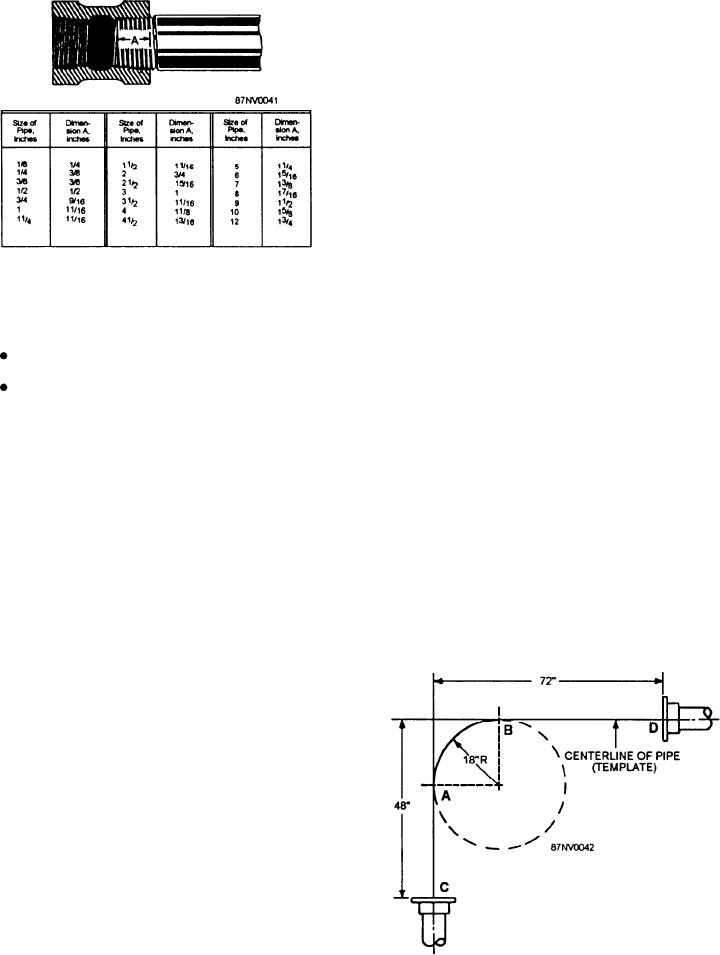should be as large as possible to prevent weakening of
the pipe and restriction of fluid flow. Six times the pipe's
diameter is a good rule, but there will be times when a
smaller radius is required. Too small a radius will flatten
the heel and wrinkle the throat of the pipe at the bend.
90-DEGREE PIPING BENDS.--You may
determine the total developed length (TDL) of a section
of piping with a 90-degree bend in three easy steps.
NOTE: All dimensions and points for the follow-
ing excercise are taken from figure 16-3.
1. Subtract the bend radius from the straight
section of pipe. Using the dimensions in figure 16-3,
subtract 18 inches (bend radius) from 48 inches (straight
section of pipe), which leaves 30 inches, the distance
Figure 16-2.--Length of thread on pipe required to make a
tight joint.
from points A to C. To get the distance from B to D,
subtract 18 inches from 72 inches, which leaves 54
inches.
Serious injury to personnel
2. To figure out the total length of pipe for the bent
90-degree section of pipe, simply multiply the bend
Loss of a vital system that has no standby system
radius by a constant of 1.57. In this case, our bend radius
Where threaded fittings are not authorized, you will
of 18 inches multiplied by 1.57 gives us a total length
use a socket fitting. As in threaded pipe, you must add
of 28.26 inches for dimension AB in figure 16-3.
allowances to the "as taken" measurement of socket
3. To get the TDL, the final step is to add the length
fittings before cutting a length of pipe. The allowances
of the legs to the length of the bent section (30" + 54"
vary from brazed and welded socket fittings. In brazed
+ 28.26" = 112.26"). At this point, you may convert the
fittings, you must add the depth of the socket to the
decimal measurement into a fraction for easier use in
length of pipe before cutting. In welded fittings, there
measuring a section of pipe.
are several special allowances to take into consideration
when measuring your pipe. All welded piping systems,
PIPING BENDS OTHER THAN 90
regardless of material or service, require the use of a
DEGREES.--To compute the TDL for bends other
small end gap clearance of l/l6 to l/8 inch between the
than 90 degrees, a slightly different process is used. This
pipe end and the fitting. This end gap clearance allows
for thermal expansion of the pipe end in the socket. You
must also take into consideration the reduced socket
depth if you are reusing a welded socket fitting. When
you remove the pipe from the fitting, you must remove
part of the fitting to eliminate the fusion area of the weld,
thereby reducing the socket depth. Refer to
MIL-STD-22 for exact fit-up of welded joint designs.
As you can see, allowances and measurements for
socket fittings are more exact than those for threaded
fittings.
Pipe Length Problems
The amount of pipe needed for a bend in a piping
system must be computed during the layout stage. If the
system permits bends to be used instead of elbows,
make the necessary allowance for the extra pipe
required to make the bend before you cut the pipe to
Figure 16-3.--Figuring the approximate length of pipe for a
size. The first step is to determine the bend radius, which
90-degree bend.
16-3






